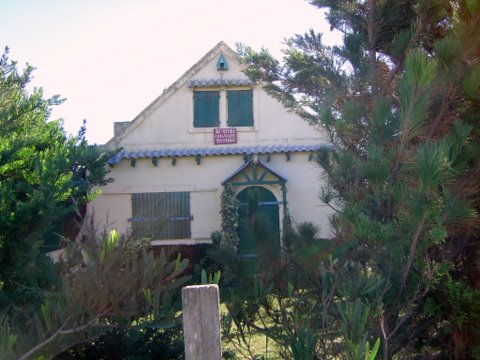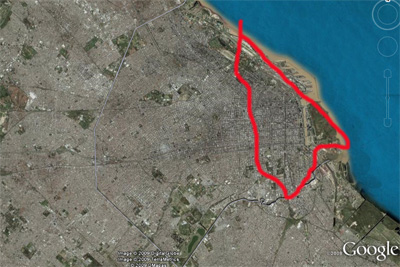Having returned earlier this month to Glasgow, the city of his birth, to attend the launch event for 40 Glasgow Voices, published recently in Issue 10 of The International Literary Quarterly or, as it is otherwise known, Interlitq (www.interlitq.org), Peter Robertson, the Argentine-based publisher and founding editor of the review, acknowledges that this feature, showcasing Glasgow’s contemporary literary talent, and complemented by images from the Cranhill Arts Centre’s Glaswegians Photo Archive, is a literary venture close to his heart.

The “40 Glasgow Voices” launch event on April 8th, 2010 with writers (from left to right) Sue Reid Sexton, Jane Goldman, Laura Muetzelfeldt, Peter Robertson, Ewan Morrison, Gerrie Fellows, Donal McLaughlin, and Claire Quigley
“My goal is to ensure that Glasgow’s eclectic, and often edgy, literature receives the international exposure that it deserves and, considering Interlitq’s scope and burgeoning readership, I am confident that the review is a perfect vehicle for achieving such an objective.”
Transcending the unquestionable talent of the city’s multitudinous literary voices, as evidenced by contributions from the feature’s masterful exponents of prose, poetry, literary criticism and translation, there is another, more personal, reason why Peter Robertson has selected Glasgow as the focus for the first of several major features that Interlitq will be publishing this year, with the spotlight shifting to Miami and New Zealand later in 2010.
“Glasgow is where I will always have my roots. Even though I left the city when I was eleven, and have lived in many different countries, and indeed continents, having been based now in Argentina for more than ten years, I do identify with what I regard as a recurring attribute of the Glaswegian personality, that fusion of bonhomie and doughtiness”“there can be a real warmth underlying an indomitable fighting spirit.”
And yet, perhaps this combative quality that Peter Robertson refers to is not so much his ancestral inheritance, but rather a trait that the circumstances of his early life forced him to acquire.
“My father, who had overcome poverty, founded companies and was successful in business for a number of years that coincided with my childhood. My early life in Glasgow was, in a sense, idyllic. We lived in a big house in Bearsden and belonged to a close-knit local community that was a social enclave, and very much its own world. And then came the collapse of everything, suddenly I didn’t have a father, and we had to move to the less salubrious south of the city. Initially an outsider in a hostile environment, I was conscious, at a relatively young age, of a collision of cultures. But there was much that was to prove humanizing about this other environment, and I came to see that, had my cocooned and privileged life continued, it might well have been too narrow. I do believe that there is considerable strength in diversity, in the rejection of narrow allegiances, and I like to think that this cherished value of mine permeates Interlitq.”
Returning to Glasgow this early spring, and retracing the streets of his childhood, Peter Robertson is buoyed up by the fact that, having successfully profiled the work of 40 Glasgow Voices in The International Literary Quarterly, he has not only found an effective way to reconnect with the city through its literary voices, but he has also been in a position to give something back to the city that shaped him. “I have been able to provide Glasgow with this platform from which to project itself internationally, and this feels to me like one way of paying what I consider to be a long-standing debt of gratitude.”
As he leaves Glasgow behind him once again, to return to London, and then to Argentina, Peter Robertson is well aware that the “Glasgow Voices” have long formed a continuum that he will never be able to silence. Indeed, all these years he has been engaged in an internal dialogue, by turns reassuring and unnerving, with such a chorus. And so it is not so surprising that many years later, and from a vastly different continent, he has returned to the city of his birth to validate those voices that, far from home, will always linger.
Merely checking to see how this picasa->lighbox plugin works, this Flickr embed….BTW, this photo was taken very early one morning back in 2005 in the neighborhood of Once. For some reason, perhaps because I so clearly remember this early morning walk, this remains one of my favorite photos.
Time to pause and read a bit of Borges on the 110th anniversary of his birth in Buenos Aires: August 24, 1899.
If you’re not sure where to start, here’s my top 10 stories by Borges, part of a series of posts I wrote back in 2006: 30 Days with Borges.
I ventured inside a bookstore on Av Las Heras and was surprised to see on the front table an unexpected set of fiction works: a 3 volume collection of stories by H.P. Lovecraft (here in Spanish translation, of course).
The front tables in bookstores are usually reserved for the books that are highly promoted. Actually, in the U.S. publishers often pay booksellers for that space, especially at the big chain stores. That might very well be true at the chains here, such as El Ateneo & Cúspide. But I felt a bit of joy that a bookstore in Buenos Aires (or anyplace) featured Lovecraft so prominently.
Sidenote: Yesterday, August 20 was the 119th anniversary of Lovecraft’s birth.
Long-time readers of this blog know that our Buenos Aires home was on the border of San Telmo and Barracas. But since last November we’ve been staying at a place in Recoleta. A short-term housesitting gig turned into a longer opportunity. It’s one of those beautiful Recoleta apartments…an absolutely astonishing staircase.

Good to experience what it’s like to live in a different part of the city, but I have missed the edge of San Telmo and Barracas, particularly Bar Britanico and Hipopótamo. Around Recoleta I just can’t find any good cafes with that type of character. All the places around Recoleta are too posh & modern for my tastes (and maybe that’s just reflective of the neighborhood). Any recommendations?
Our house in Mar del Sur is under renovation. We plan to move to the coast in December, right in time for the Argentine summer…yeah!
That means I only have a few more months to enjoy the city of Buenos Aires. Oh, I’ll be back for visits…just six hours away by bus… but it may be a long time before I live here again. There’s so much of Buenos Aires that I’ve still not seen…so many streets I want to re-visit…so much more to blog about. I’ll try to do more blogging in these upcoming four months.
Ceci & I launched a new phase of our Buenos Aires adventures today with the purchase of a house in Mar del Sud

We’re not totally abandoning the city life for a cottage by the sea…at least, not yet…and this blog will continue at its recent sporadic space…but future postings also will include an occasional mention of our new home out along the coast of Buenos Aires province.
If you’re not familiar with the charm of Mar del Sud (also known as Mar del Sur), then take a look at the fantastic photos of Mar del Sur by Max Gioffre. He has some really great photos.
Casual conversations often lead to unexpected discoveries. The other day I walked over to Palermo to have coffee with Peter Robertson and talk about future plans for The International Literary Quarterly (interlitq). We had just finished releasing issue 7. Even though Peter and I both live in Buenos Aires, we edit and prepare each issue virtually via e-mail and transferring files around the net. So getting together to talk in person is a rare treat.
Among the news Peter had for me was that Alain de Botton was joining the board of consulting editors for interlitq. And since this is more or less a travel blog, I must mention that Alain de Botton’s excellent book The Art of Travel should be read by all travelers.
should be read by all travelers.
Artists on Menorca
Speaking of traveling, Peter told me about a recent trip to the island of Menorca. When I lived in Miami Beach, I had a roommate from Menorca. (A shout out to Carmen wherever she may be today.) Anyway, Peter was on Menorca to to meet Kenneth Draper & Jean Macalpine, who will be guest artists for upcoming issues of interlitq. I had to admit that I wasn’t familiar with their artwork but after viewing the websites of Kenneth Draper and Jean Macalpine I’m delighted to become acquainted with this “new” discovery.
Draper’s work is a wonderfully colorful collection of mixed media art and Macalpine creates fantastic hand toned photographs. You have to visit their websites: Kenneth Draper and Jean Macalpine.
Peter sent along this photo of him with Draper in Menorca.

Draper is a very recognized artist. He is a Royal Academician, which is something quite important and evidently Brits know what the letters RA signify after a person’s name, but most of us Americans are clueless about those initials. RA signifies that one is a member of the Royal Academy of Arts, and Ken Draper has his own page on the Royal Academy site.
While Draper & Macalpine have exhibited in London, they regularly sell their work to international private clients, and are now keen to give exhibitions on the Iberian peninsula and thereby, through their art, transmit the unique and ravishing beauty of Menorca to those living on the Spanish mainland.
Keep your eyes on the interlitq blog for announcements about the upcoming issues of interlitq featuring the artwork of Kenneth Draper & Jean Macalpine.
Now, Ceci & I just need to figure out how to work out a visit to Menorca into our travel plans.
Last night I took a taxi from Recoleta out to Liniers, a barrio on the southwestern edge of the capital district of Buenos Aires. I tend to think that I know Buenos Aires very well, but in the cab ride I was reminded by the vast amount of Buenos Aires that I do not know, barrios that I’ve never visited or have only passed through on the bus.
This aerial view from Google Earth shows the section of Buenos Aires that I know quite well, outlined in red. I have walked almost all of the streets in these barrios: San Telmo, Boca, Barracas, Constitucion, Parque Patricios, San Cristobal, Balvanera, Montserrat, Puerto Madero, San Nicolas, Retiro, & Recoleta.

Others areas are familiar and comfortable to me, such as Belgrano, Palermo, Caballito, Almagro, Boedo, Chacarita, & Flores.
But last night in the taxi I saw many charming aspects of Buenos Aires as we passed through barrios such as Floresta, Villa Gral. Mitre, Villa Luro (which I’m not sure I even knew existed) on our way to the border of Liniers and Mataderos and just a stone’s throw from Av Gral Paz. There’s some really great architecture that exists in the most unexpected of places. I’m probably not going to have the chance anytime soon to broaden my Buenos Aires experience to the western barrios, but there are many areas where I want a closer look…out of the taxi, not on the bus, but by walking the streets.
I was recently contacted by the folks at Miniature Studios about their new Spanish language learning product Bueno, entonces.
[Disclaimer: Miniature Studios did provide me with free access to the product in exchange for this review, but otherwise there was no payment for this review and there are no affiliate links in this post.]
Ever since my days implementing digital technologies in higher education I’ve been very interested in multimedia-based approaches to learning. There are different learning styles and some people learn better in ways that are different from others. Of course, language learning always requires a high degree of personal interaction to achieve any level of proficiency. But language tapes and computer-based approaches serve as useful starting points.
Bueno, entonces is a series of animated videos that replicate a one-on-one Spanish class. Unlike most learning Spanish resources online, Bueno, entonces is designed specifically for the person who wants to live in Buenos Aires, or at least have an extended visit to Buenos Aires and have a good time.
And the good time aspect is an intentional part of this approach in learning Spanish. Not only does Bueno, entonces adopt the local pronunciation and use of vos rather than tu, there’s a bit of Argentine slang that is covered in a humorous way.
The class is presented through the characters of David, a dorky British guy who just arrived in Buenos Aires from London and Jimena, a sexy, young Argentine that is teaching him Spanish.

David is a caricature of the twenty-something guy that we’ve all met who comes down to Buenos Aires to hang out. There’s a lot of flirting and sexual innuendos from David as he tries pathetically to seduce Jimena in the class. That light tone to this series actually makes for a more entertaining experience than that offered by most language learning audio tapes and computer-based approaches, which are generally dry monotones.
If you don’t know Spanish and you are planning to come to Buenos Aires, but have not yet arrived, then Bueno, entonces is worth investigating. If you’re already in Buenos Aires, then you’ll probably just want to sign up for a real course here or find your own one-on-one instructor. Of course, the expats I know that speak the best Spanish always seem to be the ones that have a boyfriend/girlfriend that does NOT speak English. Perhaps Bueno, entonces can give you the language basics that you need to find to find the Argentine of your dreams in Buenos Aires.
Bueno, entonces is certainly better than most language learning audio tapes on the market, other than Pimsleur which I’ve always thought are by far the best audio-only approach though the monotone of Pimsleur’s speakers gets boring after a while. And, personally, I like images to go along with audio and that’s a niche that Bueno, entonces fits. Plus, the video is optimized for the iPhone and iPod Touch. That’s really cool.
And, if you’re interested, you can hop over and follow the Bueno, entonces blog.
« Previous Page — Next Page »





